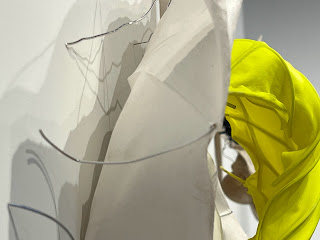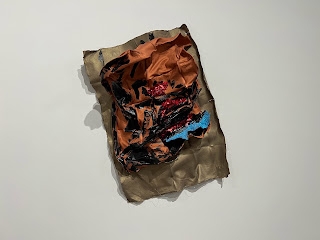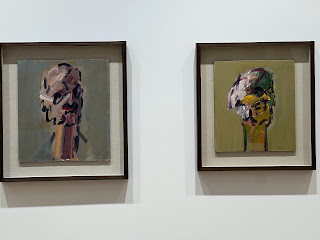But first a studio visit to Lilian Garcia-Roig showing work from her Millay residency in Susanna Coffey's studio at the Clemente.
Detail, showing a new clarity, which she attributes in part to thw seasonal baring of branches but for me too, relates to the use of projection in her Cuban series.
She is a lover of rocks.
Autumnal forests inspire Garcia-Roig because
Autumn gives her the chance to explore structure: en plein air! Impressive large paintings.
Lynda Benglis at 125 Newbury in Skeletor, a show of insect-like structures made with twigs, abaca paper, and paint.
Benglis likens the forms to insects for the skeleton and thin protective layer surrounding.
Matte and shiny effects of paint on folded paper.
Front.
From close to.
Side-back.
Shiny surfaces and glitter make their appearance.
Benglis' curiosity and experimentation continues.
Jutta Koether and Cecily Brown, not a combination that comes readily to mind, but exciting! at Bortolami.
A long row of scroll-shaped paintings I thought by Koether, but wonder if they are collaborative.
This is Cecily Brown! The tender relief, 2023, oil on linen, 13 x 17 inches, presented with Paula Cooper in the gallery. This painting prompts me to think the scrolls are collaborative, because I wouldn't expect this diaphanous abstraction from Brown usually--whereas I do of Koether.
Above, Koether, Holding, 2023, oil on canvas, each of 6 parts 11 x 14 inches.
Below, Brown, The Rhythm of the Night, 2023, oil on linen, 37 x 59 inches.
Detail from Rhythm of the Night.
At the exit, contrasting views of nudity: Koether's More Naked Than Naked, 2016, acrylic on canvas, 39 x 36 inches.
Brown's Boy Trouble, from 1999, oil on linen, 75 x 90 inches.
Hilary Harkness at PPOW showing a series of small paintings framed with museum glass, telling the history of a family during the Civil War, how the experience changed and affected them generationally. There are racial shifts in power and sexuality undermining historical narratives.
A birth scene resembles Poussin's Abduction of the Sabine Women.
The sylvan landscapse from Watteau transposes questions of what if? Was it? And how?
Vignettes of secret meetings in the tent.
Refashioning Courbet's The Meeting (aka Bonjour, Monsieur Courbet), 1854, in which the artist meets his patron based on a mythical narrative of "the wandering Jew," who by mocking Jesus was cursed to walk the earth (it is said). In Courbet's painting, the artist and patron meet as equals and in this Harkness, the woman in the tent meets a crew of defectors? with fastidious technique.
A second narrative in the exhibition's second room involves Alice B. Toklas and Gertrude Stein in 1940s Paris.
There are famous paintings, severed heads,
and movie star glamor.
Stein serves her guests.
A third narrative imagining Jackson Pollock's show at Peggye Guggenheim's Art of This Century Gallery, depicts a nude, Black Lee Krasner touching up a Pollock.
It is rare to see this level of detail behaving very much like film in terms of viewing experience.
Katherine Bradford at Canada: family portraits reflecting a time where the world seems to be floating in space. So too these figures, sometimes voiceless or faceless, wade through pools and orbits in suspension.
Ghostly forms come out at night, reaching for each other, connected, yet alone.
Color, dragged on top of color, emitting heat that glows.
Space comprised of singular configurations.
Water is Bradford's touchstone; her first Canada show also focused on swimmers, and at Thorpe she painted ships at sea. The simplified contours of figures with colors running through them supports the water motif.
At Freight + Volume, a solo exhibition by Mary de Vincentis, large canvases up front and in the back small paintings both beautiful and surprising, this bird, for one--many treatments of paint to form the bird and cloud configurations.
Another small painting, more casually treated but convincing in the horrific discovery of a shooter.
A parable among trees through which a star halo shines. These combinations at intimate scale reveal a lively facture and imaginative translation.
Frank Auerbach's reclining portraits of his wife Julia at Lurhing Augustine in its new Tribeca Location, White Street on the west side of Sixth Avenue.
Materializing, dematerializing, the process does not fail to delight.
Bravura painting, beautiful color and surface.
The way muscle and flesh inform each other, and separate from each other.
There are different moods in how we see a person, and then there is
The immutability of mass.
















































































No comments:
Post a Comment